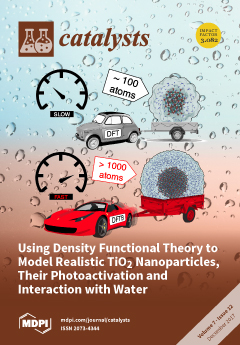Novel allyl cobalt complexes, i.e., (η
3-C
4H
7)(η
4-C
4H
6)Co(PCyPh
2) (
1), (η
3-C
4H
7)(η
4-C
4H
6)Co(PMePh
2) (
2) and (η
3-C
5H
9)(η
4-C
5H
8)Co(PMePh
2) (
3), were synthesized by reacting CoCl
2(PRPh
2)
2 (R = methyl, cyclohexyl) with 1,3-butadiene or isoprene in presence of metallic zinc. The complexes were fully characterized by Nuclear Magnetic Resonance (NMR) spectroscopy (
1H and 2D experiments); in case of
1, single crystals, suitable for X-ray analysis, were obtained and the molecular structure was determined. The allyl cobalt phosphine complexes alone gave highly crystalline 1,2 polymers from 1,2-propadiene, but they did not polymerize 1,3-dienes. Nevertheless, in the presence of a stoichiometric amount of methylaluminoxane (MAO), they were able to polymerize 1,3-butadiene and substituted 1,3-butadienes such as isoprene, (
E)-1,3-pentadiene, (
E)-1,3-hexadiene, and (
E)-3-methyl-1,3-pentadiene. Specifically,
1/MAO gave predominantly syndiotactic 1,2 polymers from 1,3-butadiene and terminally substituted 1,3-butadienes (e.g., 1,3-pentadiene and 1,3-hexadiene), but it was practically not active in the polymerization of internally substituted 1,3-butadienes (e.g., isoprene and 3-methyl-1,3-pentadiene);
2/MAO and
3/MAO exhibited instead an opposite behavior, giving predominantly isotactic 1,2 polymers from 3-methyl-1,3-pentadiene, and showing very low activity in the polymerization of 1,3-butadiene, 1,3-pentadiene and 1,3-hexadiene. The results obtained are interesting from the mechanistic point of view, and some hypotheses to explain this particular behavior were formulated.
Full article





